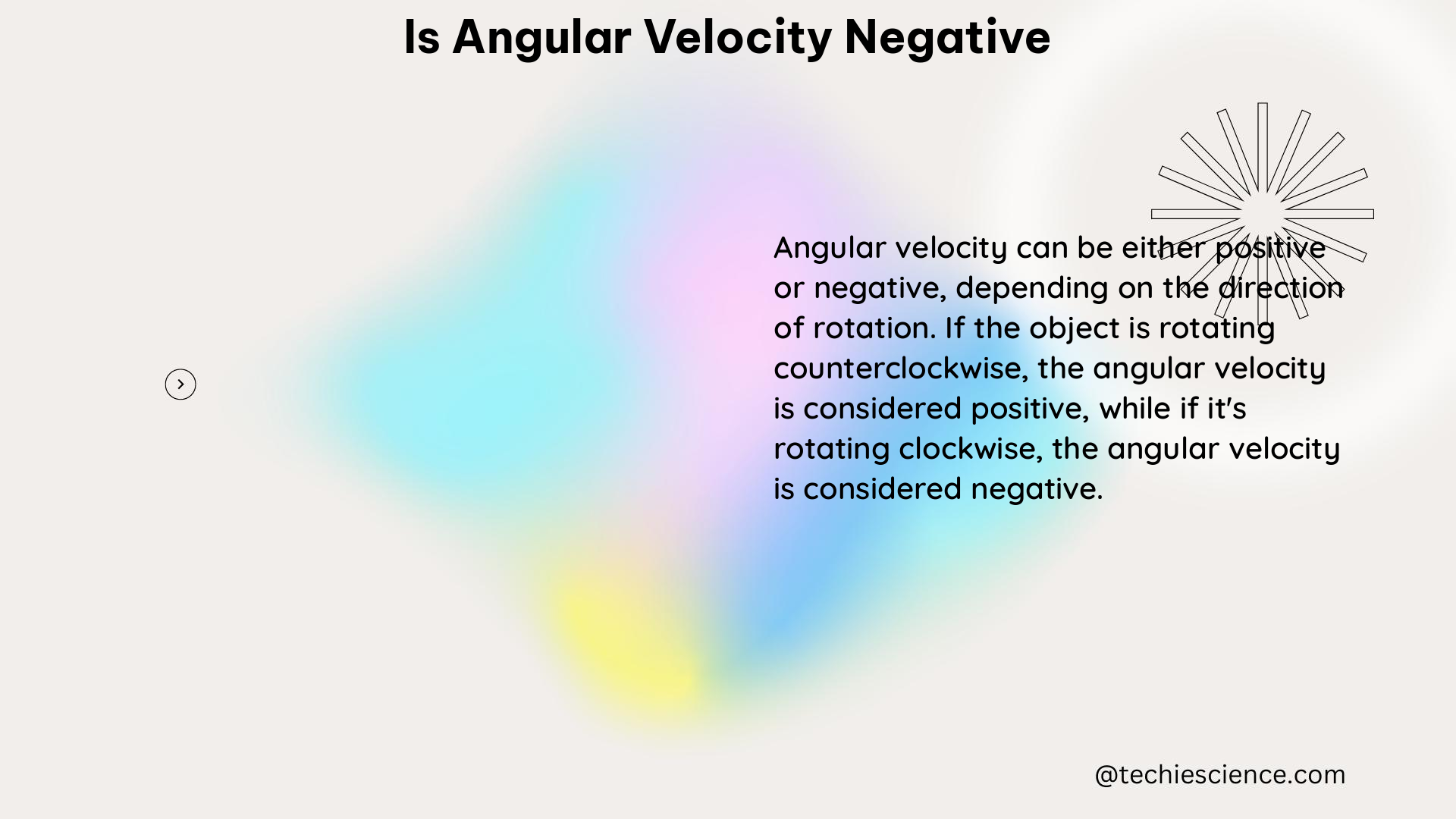Angular velocity is a fundamental concept in physics that describes the rate of rotation of an object around a fixed axis. It is a vector quantity, meaning it has both magnitude and direction. The sign of the angular velocity depends on the direction of rotation, with positive values indicating counterclockwise rotation and negative values indicating clockwise rotation in a right-handed coordinate system.
Understanding Angular Velocity
Angular velocity, denoted by the symbol ω (omega), is defined as the rate of change of angular displacement with respect to time. It is measured in radians per second (rad/s) and can be calculated using the following formula:
ω = dθ/dt
Where:
– ω is the angular velocity (rad/s)
– θ is the angular displacement (rad)
– t is the time (s)
The direction of the angular velocity vector is perpendicular to the plane of rotation and is determined by the right-hand rule. If the rotation is counterclockwise, the angular velocity vector points in the positive direction. If the rotation is clockwise, the angular velocity vector points in the negative direction.
Positive and Negative Angular Velocity

As mentioned earlier, the sign of the angular velocity depends on the direction of rotation. Here’s a more detailed explanation:
- Positive Angular Velocity:
- Counterclockwise rotation
- The angular velocity vector points in the positive direction
-
The value of the angular velocity is positive (e.g., ω = 5 rad/s)
-
Negative Angular Velocity:
- Clockwise rotation
- The angular velocity vector points in the negative direction
- The value of the angular velocity is negative (e.g., ω = -3 rad/s)
It’s important to note that the sign of the angular velocity is relative to the chosen coordinate system. In a right-handed coordinate system, the positive direction is typically chosen to be the counterclockwise direction, and the negative direction is the clockwise direction.
Relationship between Angular Velocity, Angular Displacement, and Angular Acceleration
The angular velocity, angular displacement, and angular acceleration are closely related. Here’s how they are connected:
- Angular Displacement (θ):
- Represents the change in the angular position of an object
- Measured in radians (rad)
- Positive angular displacement corresponds to counterclockwise rotation
-
Negative angular displacement corresponds to clockwise rotation
-
Angular Velocity (ω):
- The rate of change of angular displacement with respect to time
- Measured in radians per second (rad/s)
- Positive angular velocity indicates counterclockwise rotation
-
Negative angular velocity indicates clockwise rotation
-
Angular Acceleration (α):
- The rate of change of angular velocity with respect to time
- Measured in radians per second squared (rad/s²)
- Positive angular acceleration indicates an increase in angular velocity
- Negative angular acceleration indicates a decrease in angular velocity
The relationships between these quantities can be expressed mathematically as follows:
ω = dθ/dt
α = dω/dt
These equations show that the angular velocity is the first derivative of the angular displacement with respect to time, and the angular acceleration is the first derivative of the angular velocity with respect to time.
Examples of Negative Angular Velocity
Here are some examples of situations where negative angular velocity can occur:
- Rotating Wheel Slowing Down:
- Consider a rotating wheel that is slowing down due to friction or braking.
- As the wheel slows down, the angular velocity decreases.
-
The angular velocity vector points in the clockwise direction, resulting in a negative angular velocity.
-
Rotating Door Closing:
- When a door is closing, it rotates around its hinges in the clockwise direction.
-
The angular velocity of the door is negative, as it is decreasing the positive angular displacement.
-
Gyroscope Precession:
- In a gyroscope, the angular velocity vector can change direction, resulting in precession.
-
During the precession, the angular velocity vector may point in the negative direction, indicating clockwise rotation.
-
Planetary Orbits:
- In a planetary system, the orbits of planets around the Sun can be described using negative angular velocity.
- For example, the angular velocity of a planet orbiting the Sun in a clockwise direction would be negative.
Numerical Examples
- Rotating Wheel Slowing Down:
- Initial angular velocity: ω₀ = 10 rad/s (counterclockwise)
- Final angular velocity: ω = -5 rad/s (clockwise)
- Angular acceleration: α = (ω – ω₀) / t = (-5 – 10) / 2 = -7.5 rad/s²
-
The negative angular acceleration indicates a decrease in the angular velocity, resulting in a negative final angular velocity.
-
Rotating Door Closing:
- Initial angular displacement: θ₀ = 0 rad (door fully open)
- Final angular displacement: θ = -π/2 rad (door fully closed)
- Time taken: t = 2 s
- Angular velocity: ω = (θ – θ₀) / t = (-π/2 – 0) / 2 = -π/4 rad/s
- The negative angular velocity indicates a clockwise rotation of the door.
These examples demonstrate how negative angular velocity can arise in various physical situations, and how it is related to the direction of rotation and the changes in angular displacement and angular acceleration.
Conclusion
In summary, angular velocity is a vector quantity that can have both positive and negative values, depending on the direction of rotation. Positive angular velocity corresponds to counterclockwise rotation, while negative angular velocity corresponds to clockwise rotation. Understanding the concept of positive and negative angular velocity is crucial in analyzing the rotational motion of objects and their associated dynamics.
References:
Hi, I’m Akshita Mapari. I have done M.Sc. in Physics. I have worked on projects like Numerical modeling of winds and waves during cyclone, Physics of toys and mechanized thrill machines in amusement park based on Classical Mechanics. I have pursued a course on Arduino and have accomplished some mini projects on Arduino UNO. I always like to explore new zones in the field of science. I personally believe that learning is more enthusiastic when learnt with creativity. Apart from this, I like to read, travel, strumming on guitar, identifying rocks and strata, photography and playing chess.